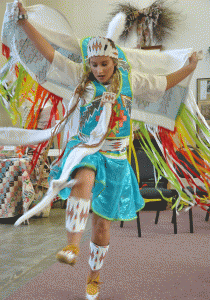LBWCC Luverne Center hosts annual Multicultural Celebration
Published 10:47 am Thursday, November 17, 2016
Tuesday morning, the students and faculty of LBW Community College Luverne Center were able to experience a bit of culture unlike what they see on a day-to-day basis.

: Pictured is Summer Stephens performing the traditional Creek Indian Fancy Shawl Dance at the LWB Luverne Center’s annual Multicultural Celebration (Photo by Beth Hyatt).
Once again, the Luverne Center played host to its annual Multicultural Celebration, which gave audiences the chance to dive headfirst into an experience like no other.
“Through this unique, annual celebration, we have become more aware of the many wonderful cultures and diversities that make up our own college, our home here in Crenshaw County and our state,” said Laura Elliott, director of the Luverne Center.
“We all need to learn how important it is to learn from one another and make the best experience out of the association that we have with each other.”
This year, students from Korea, China, Japan, Thailand and more were able to bring a bit of their home culture into the lives of Crenshaw County students. One Crenshaw Christian Academy student even had the chance to demonstrate her love for her heritage by performing a ceremonial dance.
Michelle and Summer Stephens served as the guest speaker and performer for the day. Both women are members of the local South Eastern Muscogee (Creek) Nation; both were able to share their heritage with the audience through spoken word and dance. Their tribal land is located in Pike County.
“It means so much to me that the Creek culture is still alive and thriving to this day. I am so fortunate to be a part of such an interesting heritage. I just hope that the Native American culture continues to live on through many generations,” Summer said.
According to Michelle, 500 years ago the Muscogee lived in Georgia and Alabama; 1,000 years ago they lived on mounds in the Southeast.
“We oftentimes refer to ourselves as Creek Indians because the Europeans nicknamed us that, because we always were beside a creek or river,” Michelle said.
“But, we are Muscogee people. Our mother tribe is in Muscogee, Oklahoma.”
Muscogee people were farmers as well as hunters, and the majority of the Muscogees settled around the Chattahoochee River, the lower Tallapoosa River and the Central Coosa River.
The Muscogee Nation was made up of 30-60 towns up and down the rivers, and they lived in square houses made of plaster and river cane and had thatched roofs.
In 1814, one year after the Battle of Burnt Corn around Atmore, Alabama, Andrew Jackson signed the Treaty of Fort Jackson, which forced the majority of Muscogees off their land.
The few families that remained were only able to do so because they agreed to work for the US government. This movement is widely known as the Trail of Tears, and resulted in many Native Americans relocating to Oklahoma.
Currently, there are nine state-recognized tribes in Alabama, according to Michelle, and there is only one federally recognized tribe: the Poarch Creek Indians in Atmore.
At the conclusion of Michelle’s speech, her daughter Summer demonstrated one of the most popular ceremonial dances, the Fancy Shawl Dance, dressed in traditional, beaded regalia.
“I loved representing my Creek Native American heritage by doing a ceremonial dance that is so lively, colorful and energetic,” Summer said.
“The Fancy Shawl Dance is just one of many different styles of native dances. It is my personal favorite because it is so upbeat and exciting.”





